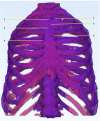Additively Manufactured Patient-Specific Anthropomorphic Thorax Phantom With Realistic Radiation Attenuation Properties
- PMID: 32457883
- PMCID: PMC7225309
- DOI: 10.3389/fbioe.2020.00385
Additively Manufactured Patient-Specific Anthropomorphic Thorax Phantom With Realistic Radiation Attenuation Properties
Abstract
Conventional medical imaging phantoms are limited by simplified geometry and radiographic skeletal homogeneity, which confines their usability for image quality assessment and radiation dosimetry. These challenges can be addressed by additive manufacturing technology, colloquially called 3D printing, which provides accurate anatomical replication and flexibility in material manipulation. In this study, we used Computed Tomography (CT)-based modified PolyJetTM 3D printing technology to print a hollow thorax phantom simulating skeletal morphology of the patient. To achieve realistic heterogenous skeletal radiation attenuation, we developed a novel radiopaque amalgamate constituting of epoxy, polypropylene and bone meal powder in twelve different ratios. We performed CT analysis for quantification of material radiodensity (in Hounsfield Units, HU) and for identification of specific compositions corresponding to the various skeletal structures in the thorax. We filled the skeletal structures with their respective radiopaque amalgamates. The phantom and isolated 3D printed rib specimens were rescanned by CT for reproducibility tests regarding verification of radiodensity and geometry. Our results showed that structural densities in the range of 42-705HU could be achieved. The radiodensity of the reconstructed phantom was comparable to the three skeletal structures investigated in a real patient thorax CT: ribs, ventral vertebral body and dorsal vertebral body. Reproducibility tests based on physical dimensional comparison between the patient and phantom CT-based segmentation displayed 97% of overlap in the range of 0.00-4.57 mm embracing the anatomical accuracy. Thus, the additively manufactured anthropomorphic thorax phantom opens new vistas for imaging- and radiation-based patient care in precision medicine.
Keywords: 3D printed thorax; additive manufacturing; computed tomography (CT) imaging; patient-specific phantom; precision medicine; radiation attenuation.
Copyright © 2020 Hatamikia, Oberoi, Unger, Kronreif, Kettenbach, Buschmann, Figl, Knäusl, Moscato and Birkfellner.
Figures










References
-
- Brouwers L., Teutelink A., van Tilborg F. A. J. B., de Jongh M. A. C., Lansink K. W. W., Bemelman M. (2018). Validation study of 3D-printed anatomical models using 2 PLA printers for preoperative planning in trauma surgery, a human cadaver study. Eur. J. Trauma Emerg. Surg. 45 1013–1020. 10.1007/s00068-018-0970-3 - DOI - PMC - PubMed
-
- Hatamikia S., Biguri A., Kronreif G., Furtado H., Kettenbach J., Figl M., et al. (2019a). “Source-detector trajectory optimization for C-arm CBCT,” in Proceedings of the Supplement of the International Journal of CARS (IJCARS), June 18–21, Rennes.
-
- Hatamikia S., Biguri A., Kronreif G., Kettenbach J., Birkfellner W. (2019b). “CBCT reconstruction based on arbitrary trajectories using TIGRE software tool,” in Proceedings of the 19th Joint Conference on New Technologies for Computer/Robot Assisted Surgery (CRAS), 21-22 March, Genova.
LinkOut - more resources
Full Text Sources

